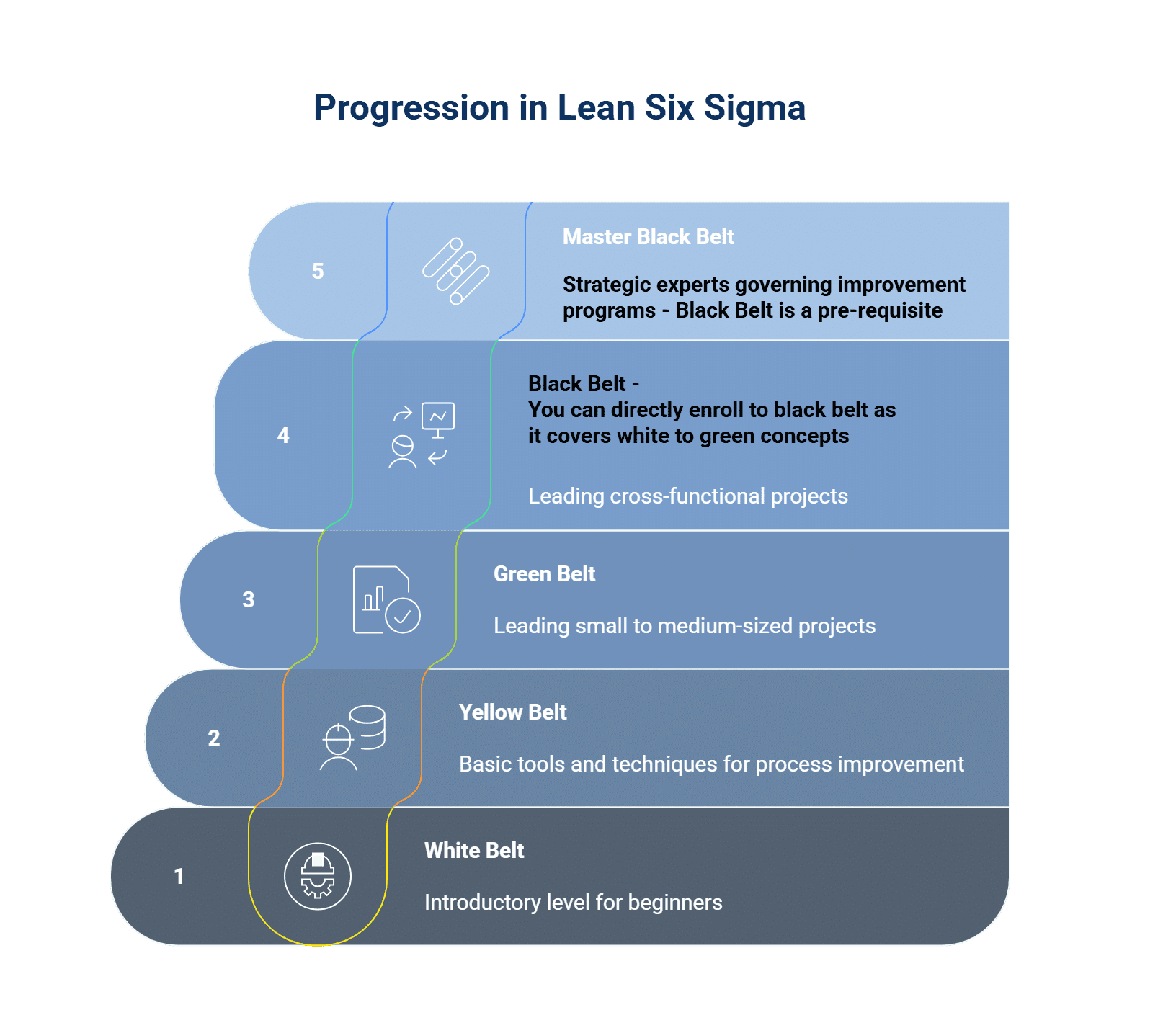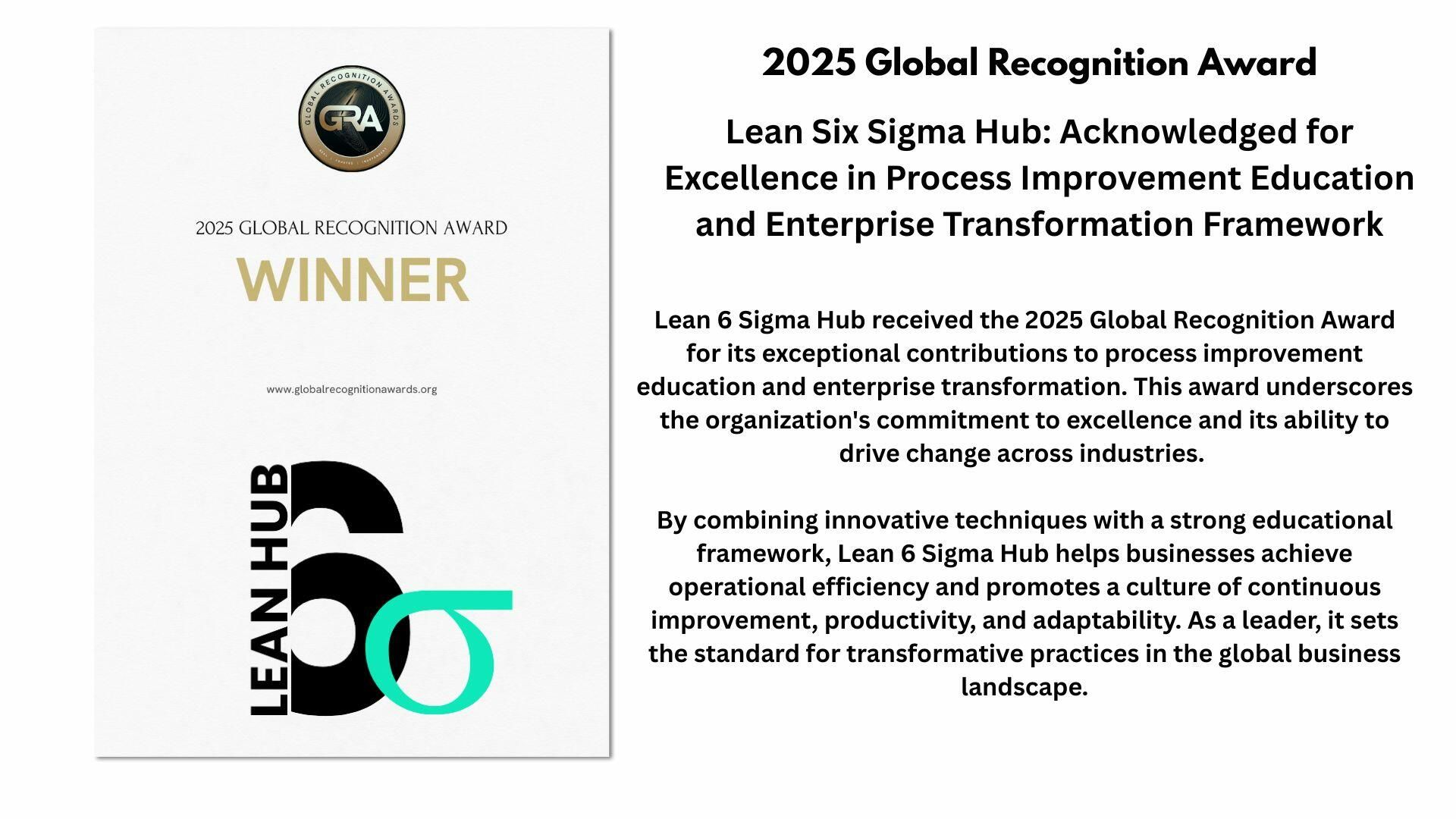Online Lean Six Sigma Training and Certification
CSSC Accredited Lean Six Six Sigma White, Yellow, Green, Black and Master Black Belt Courses with Practical Case Studies

2025 Global Recognition Award Winner
Lean 6 Sigma Hub has been awarded a 2025 Global Recognition Award for its outstanding contribution to Lean Six Sigma training, enterprise transformation, and educational innovation. This global honor affirms our mission to make continuous improvement practical, scalable, and impactful for professionals and organizations worldwide..
Council for six simga accredited
Lean six sigma Online training offerings
01
Lean Six Sigma White belt
kickstart your journey with foundational principles of process improvement with lean six sigma white belt training
02
LEAN SIX SIGMA YELLOW BELT
Master essential tools and techniques for improving processes and managing small projects.
03
LEAN SIX SIGMA GREEN BELT
Develop intermediate skills in data-driven decision-making and project management
04
lean six sigma black belt
Lead complex projects and drive organizational change with advanced strategies
05
lean six sigma master black belt
Learn to mentor Green/Black Belts, drive enterprise capability, and build governance frameworks. Includes real-life case studies, coaching blueprints, and enterprise dashboards.
Build Your Skills in Process Improvement
Learn Lean Six Sigma from beginner to advanced levels with structured self paced online courses designed for real world results.
Learn Lean Six Sigma Through Real World Simulation
Build practical skills with a full end to end case study project designed to mirror real business challenges. Learn by doing with guided examples, dummy data and real analysis tools.
Practical Application
Apply Lean Six Sigma tools to a realistic business scenario and see how each step of DMAIC works in practice.
Hands-On Experience
Work through an interactive case study with dummy data, charts, templates and worked examples.
Data-Driven Decision Making
Learn how to collect data, analyse results and make informed decisions using real project steps.
Teams Perspective
Understand how roles like process owners, analysts and project leaders work together during improvement projects.
Performance Insights
See how improvements impact cost, quality, delivery time and customer satisfaction through measurable results
Built for Self Study
All content is designed for independent learning with clear explanations, structured steps and visual guides.

Explore an End to End Lean Six Sigma Black Belt Project
Follow a complete DMAIC project from Define to Control using a fictional but realistic business problem. See exactly how decisions are made, what tools are used and how improvements are delivered.
Progression in Lean Six Sigma
Learn how each belt level builds your skills in problem solving, data analysis and process improvement. All courses are self paced and designed for online study.

White Belt
Introductory level that builds awareness of Lean Six Sigma principles, waste types, and the DMAIC framework. Ideal for beginners and front-line staff.
Yellow Belt
Covers basic tools and techniques used in process improvement. Yellow Belts support project teams with data collection and problem-solving.
Green Belt
Focused on leading small to medium-sized projects. Green Belts apply DMAIC, use statistical tools, and drive improvements within their function.
Black Belt
Advanced level for professionals who lead cross-functional projects. Black Belts use complex analytics, mentor Green Belts, and drive enterprise-level change.
Master Black Belt
Strategic experts who train and coach Belts, govern improvement programs, and align Lean Six Sigma with business goals at the enterprise level.
WHAT IS LEAN SIX SIGMA?
Lean Six Sigma is a proven method for improving processes, reducing waste and solving problems using data. It combines Lean principles that focus on speed and efficiency with Six Sigma techniques that focus on quality and reducing variation.
Improves Business Efficiency
Identify and remove non value added activities across any process to improve speed and performance.
Reduces Errors and Variations
Use the DMAIC framework and simple data tools to deliver more consistent, reliable results.
Boosts Career Growth
Lean Six Sigma certified professionals are valued across industries including healthcare, logistics, finance, IT and service.
Builds a Problem Solving Culture
Helps teams use a structured method to understand problems, test solutions and sustain improvements.

Award Winning
2025 Global Recognition Award Winner

Global Accreditation
Accredited by the Council for Six Sigma Certification

Online Training
100% self-paced online learning options

1000+ Trained
1,000+ professionals certified globally
Why Choose Lean six sigma online training from Lean 6 Sigma Hub?
Get accredited, flexible and practical Lean Six Sigma training designed for self paced online learning. Learn real tools, apply them immediately and gain certification trusted around the world.
Lean 6 Sigma Hub delivers online Lean Six Sigma training focused on real world problem solving. Each course uses practical case studies, dummy data and step by step examples so you can learn by doing, not by memorising theory. You can study at your own pace and gain a certification that is recognised globally across industries.
What Our Learners Say
News & Resources

Long-Term Process Monitoring: Setting Up Systems That Last Beyond Your Project
Organizations invest heavily in process improvements, yet most gains deteriorate within 18 months without proper monitoring systems. This comprehensive guide explores proven strategies for establishing sustainable monitoring frameworks that preserve operational improvements indefinitely, featuring practical examples and detailed implementation approaches that ensure your process enhancements deliver lasting value.

Long-Term Process Monitoring: Setting Up Systems That Last Beyond Your Project
Organizations invest considerable resources into process improvement initiatives, yet many of...


